《剑桥国际英语语音在用》之剑桥
- 格式:ppt
- 大小:5.82 MB
- 文档页数:9
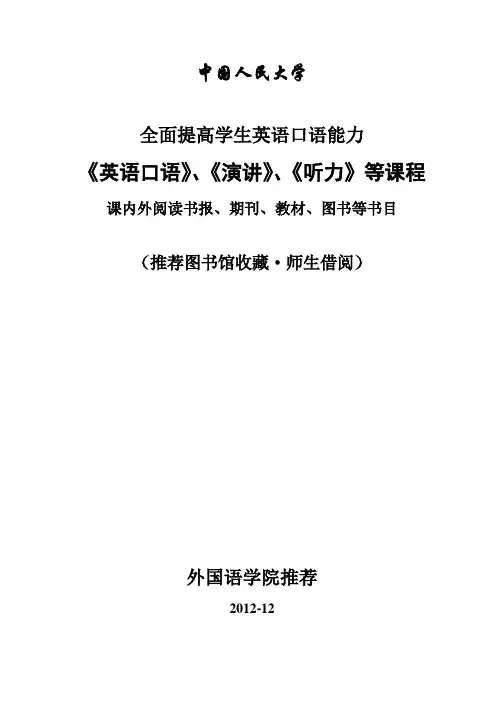
中国人民大学全面提高学生英语口语能力《英语口语》、《演讲》、《听力》等课程课内外阅读书报、期刊、教材、图书等书目(推荐图书馆收藏·师生借阅)外国语学院推荐2012-12第一部分:美国、英国、澳大利亚英语报纸、期刊以下为美、英、澳三国可供学生阅读的报纸和期刊,希望学校图书馆能购买纸质版,放在书架上供学生阅读。
一、美国报纸1. The New York Times《纽约时报》/2. The Washington Post《华盛顿邮报》/3. USA Today《今日美国》/4. U.S News & World Report《美国新闻与世界报道》/5. Los Angeles Times《洛杉矶时报》/二、美国期刊1. Reader’s Digest《读者文摘》/2. TIME《时代周刊》/3. People《人民》/4. Scientific American《美国科学》/5. The New Yorker《纽约人》/6. Atlantic Monthly《大西洋月刊》/7. Harvard Business Review《哈佛商业评论》/8. National Geographic《国家地理》/三、英国报纸1. Times《泰晤士报》/2. The Guardian《卫报》/3. The Daily Express《每日快报》/四、英国期刊1. The Economist《经济学家》/2. The Spectator《旁观者》/3. Discovery《发现》/4. Nature《自然》/5. New Scientist《新科学家》/五、澳大利亚报纸1. The Canberra Times《堪培拉时报》.au/2. Sydney Morning Herald《悉尼晨报》.au/3. The Melbourne Age《墨尔本时代》.au/六、澳大利亚期刊1. Popular Science《大众科学》.au/2. The Australian《澳大利亚人》.au/3. News Weekly《新闻周刊》.au/七、新西兰/加拿大报纸1. New Zealand Herald《新西兰信使》(新西兰) /2. The Dominion Post《统治邮报》(新西兰) /dominion-post/3. The Globe and Mail 《环球与邮件》(加拿大) /4. The National Post《国家邮报》(加拿大) /第二部分:2012-13-2学期始开出课程的书目下面是外国语学院从2012-2013第二学期开始将开设的全校英语口语、听力、文化、阅读等课程供学生使用的教材和参考书目。
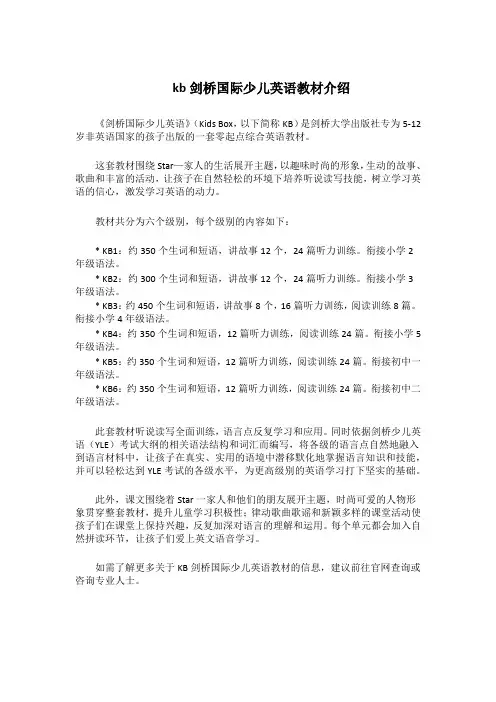
kb剑桥国际少儿英语教材介绍《剑桥国际少儿英语》(Kids Box,以下简称KB)是剑桥大学出版社专为5-12岁非英语国家的孩子出版的一套零起点综合英语教材。
这套教材围绕Star—家人的生活展开主题,以趣味时尚的形象,生动的故事、歌曲和丰富的活动,让孩子在自然轻松的环境下培养听说读写技能,树立学习英语的信心,激发学习英语的动力。
教材共分为六个级别,每个级别的内容如下:* KB1:约350个生词和短语,讲故事12个,24篇听力训练。
衔接小学2年级语法。
* KB2:约300个生词和短语,讲故事12个,24篇听力训练。
衔接小学3年级语法。
* KB3:约450个生词和短语,讲故事8个,16篇听力训练,阅读训练8篇。
衔接小学4年级语法。
* KB4:约350个生词和短语,12篇听力训练,阅读训练24篇。
衔接小学5年级语法。
* KB5:约350个生词和短语,12篇听力训练,阅读训练24篇。
衔接初中一年级语法。
* KB6:约350个生词和短语,12篇听力训练,阅读训练24篇。
衔接初中二年级语法。
此套教材听说读写全面训练,语言点反复学习和应用。
同时依据剑桥少儿英语(YLE)考试大纲的相关语法结构和词汇而编写,将各级的语言点自然地融入到语言材料中,让孩子在真实、实用的语境中潜移默化地掌握语言知识和技能,并可以轻松达到YLE考试的各级水平,为更高级别的英语学习打下坚实的基础。
此外,课文围绕着Star一家人和他们的朋友展开主题,时尚可爱的人物形象贯穿整套教材,提升儿童学习积极性;律动歌曲歌谣和新颖多样的课堂活动使孩子们在课堂上保持兴趣,反复加深对语言的理解和运用。
每个单元都会加入自然拼读环节,让孩子们爱上英文语音学习。
如需了解更多关于KB剑桥国际少儿英语教材的信息,建议前往官网查询或咨询专业人士。

美语发音秘诀和国际剑桥英语语音The key to mastering American English pronunciation lies in understanding and practicing the following aspects:1. Vowel sounds: American English has a wide range of vowel sounds, and it's important to pay attention to the subtle differences between them. Practice pronouncing words with different vowel sounds to improve your pronunciation.2. Consonant sounds: Pay attention to the pronunciation of consonant sounds, as they can vary between American English and other varieties of English. Practice pronouncing words with challenging consonant sounds, such as "th" and "r."3. Stress and intonation: American English has a unique rhythm and intonation pattern. Pay attention to the stress placed on certain syllables in words and practice using the correct intonation patterns in sentences.4. Linking and blending: American English speakers often link words together and blend sounds when speaking. Practice linking words together smoothly to improve your overall fluency and pronunciation.5. Pronunciation drills: Regular practice is key to improving your pronunciation. Use pronunciation drills and exercises to focus on specific sounds or patterns that you find challenging.Now, let's talk about the International Cambridge English Phonetics:1. Vowel sounds: The International Cambridge English Phonetics system also emphasizes the importance of vowel sounds, and provides a standardized way to transcribe and study them. Pay attention to the symbols used in the International Phonetic Alphabet (IPA) to accurately represent vowel sounds.2. Consonant sounds: Similarly, the International Cambridge English Phonetics system provides detailed descriptions of consonant sounds, including their place and manner of articulation. Practice pronouncing words using the IPA symbols to improve your accuracy.3. Stress and intonation: The International Cambridge English Phonetics system also incorporates stress and intonation patterns in its transcription of words. Studythe symbols used to indicate stress and intonation to improve your understanding and use of these features.4. Linking and blending: The International Cambridge English Phonetics system is also useful for studyinglinking and blending of sounds in English. Pay attention to the symbols used to indicate connected speech in the IPA to improve your pronunciation.5. Pronunciation drills: Use the International Cambridge English Phonetics system as a tool for practicing and improving your pronunciation. Focus on transcribing and pronouncing words using the IPA symbols to enhance your phonetic awareness.通过掌握这些技巧和系统,你将能够提高你的美语发音水平,并更好地理解和应用国际剑桥英语语音。
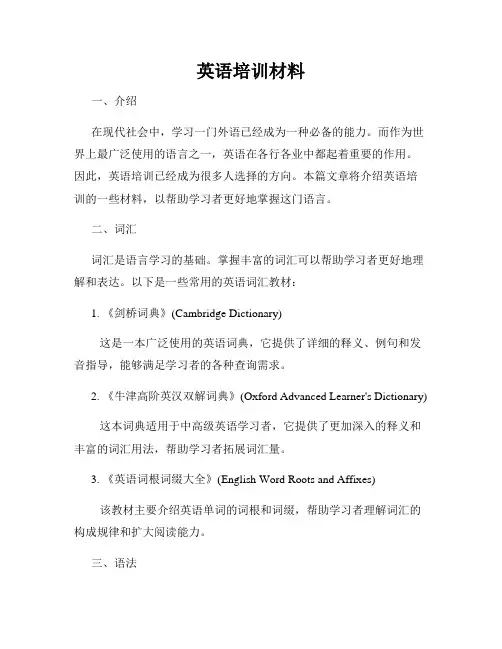
英语培训材料一、介绍在现代社会中,学习一门外语已经成为一种必备的能力。
而作为世界上最广泛使用的语言之一,英语在各行各业中都起着重要的作用。
因此,英语培训已经成为很多人选择的方向。
本篇文章将介绍英语培训的一些材料,以帮助学习者更好地掌握这门语言。
二、词汇词汇是语言学习的基础。
掌握丰富的词汇可以帮助学习者更好地理解和表达。
以下是一些常用的英语词汇教材:1. 《剑桥词典》(Cambridge Dictionary)这是一本广泛使用的英语词典,它提供了详细的释义、例句和发音指导,能够满足学习者的各种查询需求。
2. 《牛津高阶英汉双解词典》(Oxford Advanced Learner's Dictionary)这本词典适用于中高级英语学习者,它提供了更加深入的释义和丰富的词汇用法,帮助学习者拓展词汇量。
3. 《英语词根词缀大全》(English Word Roots and Affixes)该教材主要介绍英语单词的词根和词缀,帮助学习者理解词汇的构成规律和扩大阅读能力。
三、语法语法是语言学习中的另一个重要方面。
掌握英语的基本语法规则可以帮助学习者正确运用语言并提高口语和写作能力。
以下是一些常用的英语语法教材:1. 《英语语法大全》(Essential English Grammar)这本教材详细介绍了英语的各种语法规则,包括句子结构、时态、语态等内容,适用于初级和中级学习者。
2. 《剑桥英语语法》(Cambridge English Grammar in Use)这是一套系列教材,分为基础、中级和高级三个级别。
每本都提供了简明的语法解释和大量的练习题,帮助学习者巩固所学知识。
3. 《英语语法习题集》(English Grammar Exercises)该习题集主要包含了各种语法练习题,通过不断的练习加深学习者对语法规则的理解和运用能力。
四、听力听力是英语学习中的一个重要技能,也是实际应用中必不可少的部分。

课程简介:高贵品质纯正英伦式教学学校秉承剑桥大学“启蒙之所,智慧之源”的立校之本,优秀学习方法让孩子的哑巴英语瞬间脱口而出。
全球独家引进的THRASS权威自然拼读法,是纯正英伦式少儿英语学习法与“素质教育理念”的完美结合;是一套革命性的英语启蒙方法,也是少儿英语教育划时代的突破。
让您孩子英语学习命运的改变,从这一刻开始!为5-18周岁青少年量身定做,是一套真正解放英语单词记忆的神兵利器。
请相信:给孩子一个相约剑桥的机会,孩子的英语世界从此发生蜕变!课程五大特色——1. 最高效它是英联邦国家立法的少儿英语启蒙拼读法,亚洲其他地区目前最流行的语音教学法,由本校全球独家引进,在甬城家长中引起轰动,号称是要排队报名的语音速成法,融合剑桥教研室独创的“人体器官模型教学法”,神奇地实现“标准发音,快速拼写”,让中国的学生从此告别死记硬背学英语的困扰。
2. 最具创造性每期课程都帮助学习者在收获知识的同时感受着自我创造力,时刻增强自信心,提高自主学习能力和习惯。
让孩子在生动活泼的双语环境中,像搭积木玩拼图一样,将单词记忆轻松举一反三,实现“见词能读,听音能写”。
3. 最科学THRASS融合了哲学思想和少儿心智发育特点,以纠正不良发音、传授字母组合和发音方式规律、构建单词音、形、义的思维模式为目标,帮助少儿在短期内自然快速习得英文语音规律,消除机械式单词记忆困扰,从而过目不忘、终身受益。
同时,儒家德育、母语式思维、西式文化三维同步传播。
4. 最现代化母语式的学习语境,纯正英伦风格的童话式授课、中西语言文化的完美结合,彩图式课本、中外教互动式情景教学,激发学生创意式思维;再配上外研通点读笔,让孩子爱不释手,随时随地可以模仿原声发音、练习听力。
5. 最娱乐免费借阅剑桥图书室500多种外研社点读书,让孩子畅游英语文化世界。
THRASS魔法拼读墙让孩子们畅游童话的梦幻世界。
结合歌曲、绘画、童话故事、创意墙、手工DIY的缤纷沙龙课,无缝式接轨西方学习生活,让孩子们在乐学智玩中健康优质成长!官方介绍:/Curriculum/etyy.html咨询热线:4001887075学校地址:宁波海曙校区海曙区永丰路135号市图书馆(原包玉刚图书馆)一层宁波江东校区江东区百丈东路28弄嘉汇国贸B座三层(七塔寺斜对面)。

RP(正宗英式口音)《剑桥国际英语语音教程*英音版》在中国,普通话是最正确、最标准的官方语言,而在英国,虽然没有官方规定,但在英语的发展历史中,有一种发音逐渐形成其重要性,成为公认的最标准英式发音,这就是Received Pronunciation,简称为RP。
追溯其历史,Received Pronunciation最早是11世纪时形成于英格兰中南部的一支方言。
这个区域从今天的Midlands地区一直向东南延伸到伦敦,其中包含了牛津和剑桥这两个大学城。
14世纪时,Received Pronunciation被广泛在贸易商人中使用,又由于牛津和剑桥大学的崛起,这种方言被两所大学的学生所采用,于是成为受过良好教育人士的语言。
在19世纪到20世纪,Received Pronunciation成为英国公立学校的教学语言,也被英国广播公司(BBC)的播音员使用,于是又被称为Public School English 和BBC English。
Received Pronunciation这一概念,最早是英国语言学家Daniel S. Jones 在1918年的一本专着中提出的。
总结起来,Received Pronunciation有如下几个基本特点:一、 Received Pronunciation是一种标准的中性口音,被认为不带有某个特定地域的方言特点。
而在英伦三岛中,Received Pronunciation仅在英格兰使用,并且也不限区域。
二、 Received Pronunciation有明确的社会界定。
在英国,RP被认为是受过良好教育的体现,因此它特别多地和上流社会和中上阶层联系在一起,有时又被称为Oxford English 和King's/Queen's English。
一个来自威尔士的煤矿工人,是绝对不懂得,也不可能操一口优雅的Received Pronunciation的。

剑桥国际英语语音入门tree or three全文共10篇示例,供读者参考篇1Tree and three are two words that sound similar but have very different meanings. Let's take a closer look at these two words and learn how to pronounce them correctly!First up, we have "tree." A tree is a tall plant with a trunk and branches that grow leaves or bear fruit. Trees can be found all around us, from the towering oak trees in the forest to the tiny bonsai trees on a windowsill. To pronounce "tree," we start with the "t" sound, then add the long "ee" sound like in the word "see." So it's "tree" with a long "ee" sound at the end.Next, we have "three." Three is a number that comes after two and before four. It's the number of fingers on each hand, the number of sides on a triangle, and the number of primary colors. To pronounce "three," we start with the "th" sound, which is a bit tricky because you have to stick out your tongue slightly, then add the "r" sound and finish with the "ee" sound. So it's "th-ree" with the "ee" sound at the end.So remember, when you see a tree, think of the long "ee" sound, and when you hear the number three, think of the"th-ree" sound with a sneaky "th" at the beginning. Practice saying these words out loud and soon you'll be able to tell the difference between tree and three with ease!Now go outside and count how many trees you can see, and then try to count to three without getting mixed up with tree. Have fun learning the difference between tree and three, and impress your friends with your new pronunciation skills!篇2Once upon a time, there were two words called "tree" and "three". They sounded pretty similar, right? But actually, they are completely different words with different meanings. Let's take a closer look at them.So, let's start with "tree". You know what a tree is, right? It's a big plant with branches and leaves that grows in the ground. Trees are important because they give us oxygen, shade, and fruits. They are also home to many animals. Next time you see a tree, just remember the word "tree".Now, let's talk about "three". This is a number, just like one, two, and four. It comes after two and before four. You can usethe word "three" when you're counting things or when you want to say there are three of something. For example, you have three toys or three apples.But why do these words sound alike? It's because of something called pronunciation. In English, some words may sound the same even though they have different meanings. That's why it's important to pay attention to the sounds of words and their meanings.To help you remember the difference between "tree" and "three", you can imagine a tree with three apples on it. This way, you can connect the two words and remember them better.So, next time you hear someone say "tree" or "three", you'll know exactly what they mean. Just remember, a tree is a plant and three is a number. Keep practicing and soon you'll be a pro at using these words correctly! Keep up the good work!篇3Hey guys! Today I want to talk to you about a tricky English pronunciation rule - the difference between the sounds "tree" and "three". These two words may look similar, but they are actually pronounced very differently. Let's break it down!First up, let's talk about "tree". When we say the word "tree", the sound we make at the beginning is a "t" sound. It's like the sound you make when you tap your tongue against the roof of your mouth. Then, we have the sound "r", which is a bit like a growling sound in the back of your throat. Finally, we have the "ee" sound, which is a long vowel sound that stretches out your mouth like you're smiling.Now, let's move on to "three". This word starts with the "th" sound, which is made by sticking out your tongue between your teeth. Next, we have the "r" sound again, just like in "tree". And finally, we have the "ee" sound once more.So what's the difference between the two? Well, the key thing to remember is that in "tree", the sound at the beginning is a "t", while in "three" it's a "th". It's a small difference, but it can really change the meaning of a word!To practice these sounds, you can try saying words that start with "tree" like "green" or "leaves", and words that start with "three" like "thirsty" or "through". Remember to pay attention to how your mouth moves and try to mimic the sounds as best as you can.I hope this helps you understand the difference between "tree" and "three". Keep practicing and you'll master these tricky sounds in no time! Thanks for listening, see you next time!篇4Hey guys, have you ever heard of the word "tree" and "three"? They sound really similar, right? But did you know that they actually have different meanings and are pronounced differently?So, let's start with the word "tree". A tree is a big plant with branches, leaves, and sometimes fruits or flowers. We can find trees in parks, forests, and even in our backyard. The word "tree" is pronounced with a long "ee" sound at the end, like when we say "wee".Now, let's move on to the word "three". "Three" is a number that comes after two and before four. We use "three" to count things like friends, pencils, or even apples. The word "three" is pronounced with a short "ee" sound in the middle, like when we say "see".So, even though "tree" and "three" sound similar, they have completely different meanings and pronunciations. It'simportant to remember the difference so that we can use the right word in the right situation.Next time you see a tree in the park, try counting the leaves on it and see if you can spot three birds sitting on a branch. Remember, it's "tree" with a long "ee" sound for the plant and "three" with a short "ee" sound for the number.Keep practicing, guys, and soon you'll be able to say "tree" and "three" perfectly! Have fun learning and exploring the world of English language. See you next time!篇5Hey guys! Today I want to talk about something super fun - the difference between "tree" and "three" in English! These two words may sound the same, but they actually mean totally different things. Let's break it down together!First off, let's talk about "tree". "Tree" is a big plant that grows in the ground and has a trunk, branches, and leaves. You can see trees everywhere, like in the park, on the street, or even in your backyard! Trees are super important because they give us oxygen and provide homes for animals. So remember, when you see a tall plant with branches and leaves, that's a "tree"!Now, let's move on to "three". "Three" is a number. It comes after two and before four. So if you have three apples, it means you have not one, not two, but three apples! You can use "three" to count things, like three cookies, three toys, or even three friends. It's a small number, but it's also a special number because it's the number of friends you need to have a party!Even though "tree" and "three" sound the same when we say them out loud, they have different meanings. So next time you see a big plant with branches and leaves, remember that's a "tree". And when you want to count something and you reach the number after two, that's "three"! Keep practicing and you'll get the hang of it in no time!That's all for today, guys! Thanks for listening and I hope you learned something new about the words "tree" and "three" in English. Stay curious and keep exploring the exciting world of language! See you next time!篇6Hey guys! Today I want to talk to you about the tricky words "tree" and "three" in English. They may sound the same when we say them, but they actually mean different things.Let's start with "tree." A tree is a big plant with branches and leaves that grows in the ground. Maybe you have a tree in your backyard where you love to play or climb. Remember, "tree" has an "ee" sound like in "beet" or "tweet."Now, let's move on to "three." "Three" is a number, like when you count, "one, two, three." It's one more than two and one less than four. When you say "three," your mouth makes a "th" sound like in "think" or "thumb," and then an "ree" sound like in "bee" or "see."So, remember, "tree" is the big plant and "three" is the number. They may sound the same, but they have different meanings. Practice saying them both out loud so you can hear the difference. Keep up the good work with your English learning and you'll soon master these tricky words! Keep practicing and you'll be an English expert in no time. Have fun learning and keep up the good work!篇7Hello everyone, today I want to talk about the differences between the words "tree" and "three" in English. These two words might sound similar, but they actually have very different meanings.Let's start with the word "tree." A tree is a tall plant that has a trunk, branches, leaves, and roots. Trees can be found all around us, in parks, forests, and even in our own backyard. They provide us with shade, oxygen, and homes for animals.Now, let's talk about the word "three." "Three" is a number, just like one, two, four, and so on. When we say "three," we are talking about the amount of things we have, like three apples, three birds, or three friends. It's important to know the difference between "tree" and "three" so that we can communicate clearly with others.To help remember the difference between these two words, you can think of a tree with three branches. That way, you can connect the meanings of the words in your mind and remember them better.I hope this explanation helps you understand the difference between "tree" and "three." Remember to practice saying these words correctly, and soon you will be able to use them with confidence. Keep learning and exploring the world of English language!篇8Hey guys, do you know the difference between "tree" and "three"? Well, let me tell you all about it! In English, these two words sound almost the same but have completely different meanings.First, let's talk about "tree." A tree is a big plant with branches and leaves that grow outside. Trees are really important because they give us oxygen to breathe and some of them even give us yummy fruits like apples and oranges. Trees are also homes for birds and squirrels, so they are super cool!Now, let's move on to "three." Three is just a number, like when you have three toys or three cookies. It comes after two and before four. You can count things using numbers, and three is just one of those numbers.So, remember, when you're talking about a big plant with leaves and branches, you say "tree." But when you're talking about the number that comes after two, you say "three." Easy peasy, right?It's important to learn the difference between these two words so you can talk about them correctly. Try saying them out loud a few times to get the hang of it. Practice makes perfect!I hope this little lesson helped you understand the difference between "tree" and "three." Keep on learning and exploring the wonderful world of English language! Bye for now!篇9Excuuuuse me, let me tell you all about this super cool thing called "tree" and "three" in English! It's so fun and easy to understand, even for us little kids!Okay, so first of all, let's talk about "tree". Tree is the big, tall plant that grows in the ground and has lots of branches and leaves. You know, like the ones we see in the park or in our backyard. Trees are super important because they give us oxygen to breathe and provide homes for animals. So remember, when we say "tree", we're talking about that big plant with roots, branches, and leaves.Now, let's move on to "three". Three is a number, like when we count "one, two, three!" It's the number that comes after two and before four. We use the number "three" to count things, like three toys or three friends. It's a fun number because it's not too big or too small, it's just right in the middle!So, the tricky part is that "tree" and "three" sound the same when we say them out loud. But remember, they mean totallydifferent things! One is a big plant with leaves and branches, and the other is a number we use to count things. It's like a little game to see if we can tell the difference when we hear them in a sentence.So, that's it for our lesson on "tree" and "three" in English! I hope you had fun learning with me, and remember to keep practicing so you can get really good at it. Thanks for listening, my friends! See you next time!篇10Hey guys! Today I want to talk to you about something super important for learning English - the difference between "tree" and "three" in pronunciation. This may seem tricky at first, but I promise it's not as hard as it seems!Let's start with "tree". So, imagine you're outside in the park and you see a big green thing with branches and leaves. What is it? That's right, it's a tree! Now, say the word out loud with me - "tree". Make sure your tongue is relaxed and your lips are slightly rounded when you say the "ee" sound.Now, let's move on to "three". This time, think about the number that comes after two. Yup, it's three! Say the word withme - "three". Notice how your mouth opens wider and your tongue touches the roof of your mouth to make the "th" sound.So, to recap - "tree" is the big green thing in the park and "three" is the number after two. Remember to practice saying these words out loud and pay attention to how your mouth and tongue move when you say them.I hope this little lesson helped you guys understand the difference between "tree" and "three". Keep practicing and you'll be speaking English like a pro in no time! See you next time!。
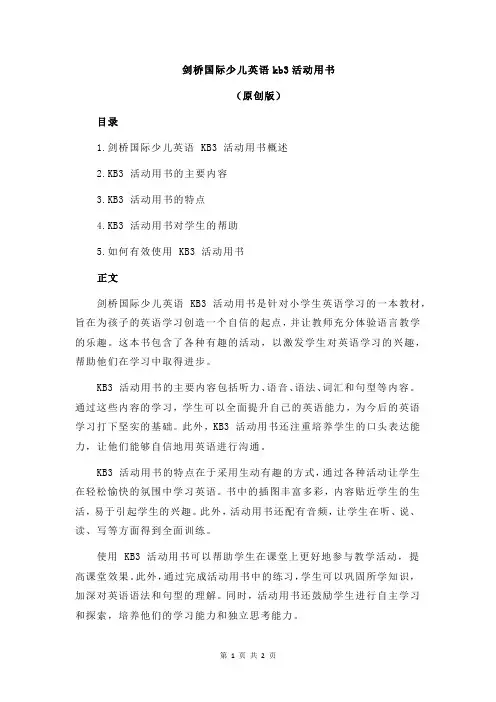
剑桥国际少儿英语kb3活动用书(原创版)目录1.剑桥国际少儿英语 KB3 活动用书概述2.KB3 活动用书的主要内容3.KB3 活动用书的特点4.KB3 活动用书对学生的帮助5.如何有效使用 KB3 活动用书正文剑桥国际少儿英语 KB3 活动用书是针对小学生英语学习的一本教材,旨在为孩子的英语学习创造一个自信的起点,并让教师充分体验语言教学的乐趣。
这本书包含了各种有趣的活动,以激发学生对英语学习的兴趣,帮助他们在学习中取得进步。
KB3 活动用书的主要内容包括听力、语音、语法、词汇和句型等内容。
通过这些内容的学习,学生可以全面提升自己的英语能力,为今后的英语学习打下坚实的基础。
此外,KB3 活动用书还注重培养学生的口头表达能力,让他们能够自信地用英语进行沟通。
KB3 活动用书的特点在于采用生动有趣的方式,通过各种活动让学生在轻松愉快的氛围中学习英语。
书中的插图丰富多彩,内容贴近学生的生活,易于引起学生的兴趣。
此外,活动用书还配有音频,让学生在听、说、读、写等方面得到全面训练。
使用 KB3 活动用书可以帮助学生在课堂上更好地参与教学活动,提高课堂效果。
此外,通过完成活动用书中的练习,学生可以巩固所学知识,加深对英语语法和句型的理解。
同时,活动用书还鼓励学生进行自主学习和探索,培养他们的学习能力和独立思考能力。
为了有效使用 KB3 活动用书,教师需要在课堂上创造积极的学习氛围,引导学生积极参与活动。
同时,教师还应根据学生的学习进度和需求,适时调整教学方法和策略。
对于学生来说,除了在课堂上认真学习外,还可以在课下通过听英语歌曲、观看英语动画片等方式,增加英语的输入量,提高自己的英语水平。
总之,剑桥国际少儿英语 KB3 活动用书是一本富有趣味性、实用性和启发性的教材,对于小学生的英语学习具有很好的辅助作用。

剑桥英语口语与语音训练素材大全
【原创实用版】
目录
1.剑桥英语口语教材 Evolve
2.剑桥国际英语语音教程
3.剑桥英语口语与语音训练素材的区别
正文
剑桥英语口语与语音训练素材大全主要包括剑桥英语口语教材
Evolve 和剑桥国际英语语音教程。
这两者都是旨在帮助学生提高英语口语和语音能力的优质资源,但它们之间存在一些区别。
剑桥英语口语教材 Evolve 是一套由剑桥大学出版社出版的六级英
语口语课程。
该教材的目标是让学生自信地说英语,提高他们在真实世界中的语言沟通能力。
Evolve 通过个性「沟通互动能力」训练阶段和同伴模式,帮助学生自然地使用英语与人交流,并增强他们的自信心。
在京东等电商平台上,可以购买到这套教材,但价格较高,整套书下来上千元。
剑桥国际英语语音教程则是一本由贝克编写的关于英语语音训练的
图书,于 2009 年由北京语言大学出版社出版。
该书主要关注英语语音的训练,帮助学生掌握正确的音标和发音。
与 Evolve 相比,剑桥国际英语语音教程更注重语音方面的训练,而 Evolve 则更注重口语沟通能力的提升。
总之,剑桥英语口语与语音训练素材大全为学习者提供了丰富的学习资源。
学生可以根据自己的需求选择适合自己的教材,提高英语口语和语音能力。
第1页共1页。

剑桥英语口语与语音训练素材大全摘要:1.剑桥英语口语教材Evolve 简介2.剑桥英语口语教材Evolve 的特点3.剑桥英语语音训练素材4.如何练习剑桥国际英语口语和语音正文:1.剑桥英语口语教材Evolve 简介剑桥英语口语教材Evolve 是由剑桥大学出版社出版的一套英语口语课程,旨在帮助学生自信地说英语。
该教材分为六个级别,适用于不同水平的英语学习者。
Evolve 通过真实的世界策略、沟通互动能力训练阶段和同伴模式等方法,帮助学生自然地使用英语与人交流,提高他们的语言沟通能力和学习动机。
2.剑桥英语口语教材Evolve 的特点(1)真实的世界策略:Evolve 通过模拟真实世界的场景,让学生在实际情境中练习英语口语,提高他们的语言应用能力。
(2)沟通互动能力训练阶段:Evolve 注重培养学生的沟通互动能力,让学生在交流过程中自然地使用英语,提高他们的口语表达能力。
(3)同伴模式:Evolve 结合真实各地学生口语示范片,贴近学习者心理,增强学生的自信心,让他们在学习过程中更加投入。
3.剑桥英语语音训练素材剑桥英语语音训练素材主要包括剑桥国际英语语音教程和剑桥国际英语语音入门等。
这些素材通过音标、句子语音等方面的训练,帮助学生掌握英语语音和语调,提高他们的英语听说能力。
4.如何练习剑桥国际英语口语和语音(1)多听:通过听英语广播、观看英语电影和电视节目等,让学生自然地接触到英语口语和语音,提高他们的听说能力。
(2)模仿:让学生模仿真实的英语口语和语音,通过反复练习,逐渐提高他们的英语口语和语音水平。
(3)互动:让学生参加英语角、语言交流活动等,与他人用英语进行交流,提高他们的英语口语和语音应用能力。
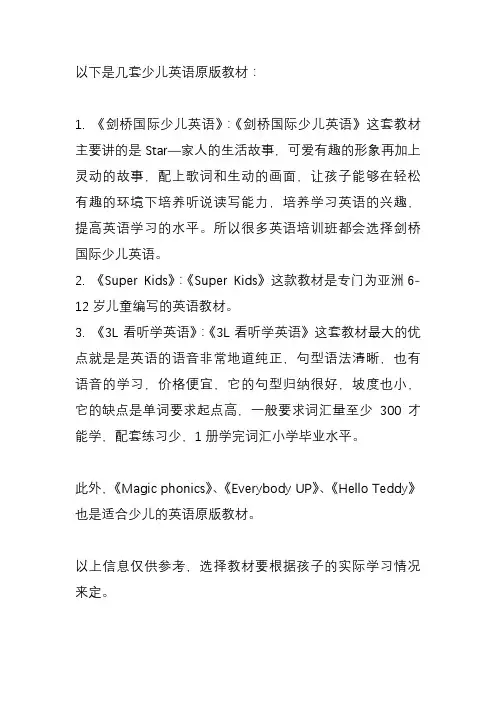
以下是几套少儿英语原版教材:
1. 《剑桥国际少儿英语》:《剑桥国际少儿英语》这套教材主要讲的是Star—家人的生活故事,可爱有趣的形象再加上灵动的故事,配上歌词和生动的画面,让孩子能够在轻松有趣的环境下培养听说读写能力,培养学习英语的兴趣,提高英语学习的水平。
所以很多英语培训班都会选择剑桥国际少儿英语。
2. 《Super Kids》:《Super Kids》这款教材是专门为亚洲6-12岁儿童编写的英语教材。
3. 《3L看听学英语》:《3L看听学英语》这套教材最大的优点就是是英语的语音非常地道纯正,句型语法清晰,也有语音的学习,价格便宜,它的句型归纳很好,坡度也小,它的缺点是单词要求起点高,一般要求词汇量至少300才能学,配套练习少,1册学完词汇小学毕业水平。
此外,《Magic phonics》、《Everybody UP》、《Hello Teddy》也是适合少儿的英语原版教材。
以上信息仅供参考,选择教材要根据孩子的实际学习情况来定。
英式发音的书籍英式发音是英国以及其他英联邦国家广泛使用的语音规范,与美式发音有着明显的区别。
为了更好地学习和掌握英式发音,我们可以借助一些优质的书籍来提升自己的听力和口语能力。
首先,推荐《英国英语发音》(English Pronunciation in Use),该书由Jonathan Marks编写,采用了系统化的教学方式,为学习者提供了全面的英式发音指导。
书中包含了丰富的练习和例句,有助于巩固知识点和提高听辨水平。
不仅如此,该书还配备了音频和练习录音,方便学习者进行跟读和自我评估。
其次,推荐《剑桥英语发音词典》(Cambridge English Pronouncing Dictionary),由Daniel Jones等人编纂。
该词典以剑桥国际英语语音学团队的研究成果为基础,收录了近200,000个英语词汇的发音,并提供了详细的音标和发音说明。
学习者可以通过该词典准确地查找并学习各个单词的英式发音。
此外,如果您对口语练习有需求,推荐《地道的英语口语练习》(Authentic English Conversation Practice)。
该书以真实的英语对话为例,涵盖了各种日常生活和工作场景,让学习者通过模仿和跟读,更好地理解和运用英式发音。
书中还提供了相关的语法和词汇知识点,让学习者能够更加自信地进行口语表达。
最后,提醒学习者注意选择适合自己水平和需求的书籍。
不同的书籍可能从不同的角度和层次教授英式发音,所以可以根据自己的实际情况进行选择和搭配。
此外,多与母语为英语的人交流、观看英剧、听英语广播等也是提高英式发音的有效途径。
总而言之,借助相关的英式发音书籍,我们可以更有针对性地学习和练习英式发音。
通过不断的学习和实践,我们的听力和口语能力将得到有效提升。
祝愿每一位学习者都能够在英式发音的掌握上取得令人满意的成果!。
剑桥国际少儿英语kb3活动用书标题:剑桥国际少儿英语KB3活动用书的使用指南导言:中括号内的内容"剑桥国际少儿英语KB3活动用书"是一套针对儿童学习英语的教材,旨在帮助孩子巩固和增强他们在学校所学的知识。
本文将以KB3活动用书为主题,为广大教师和学生家长介绍其使用方法和应用场景。
第一部分:了解KB3活动用书在使用KB3活动用书之前,我们首先需要了解它的特点和内容。
KB3活动用书是剑桥国际少儿英语系列教材中最高级别的一本,适合年龄在8至9岁之间的学生。
该用书包含丰富的教学资源,包括听力练习、口语练习、阅读材料以及各种游戏和活动。
通过这些资源,学生可以扩展词汇量,提高语法造句能力,并培养自信和独立思考的能力。
第二部分:KB3活动用书的使用方法1. 阅读理解练习:KB3活动用书包含了各种不同难度的阅读材料,学生可以通过这些材料来提高理解能力和阅读技巧。
教师可以引导学生,让他们先阅读短文,然后回答相关问题,以检验他们对材料的理解程度。
2. 口语练习:KB3活动用书中的口语练习非常重要,可以帮助学生提高口语表达能力。
教师可以组织角色扮演活动或对话练习,鼓励学生自由表达自己的意见和想法。
这样的练习有助于提高学生的语言流畅度和自信心。
3. 听力练习:KB3活动用书中的听力练习可以帮助学生提高听力技能和理解能力。
教师可以播放录音,并要求学生回答相关问题或进行听写练习。
这样的练习有助于培养学生对英语语音和语调的敏感度。
4. 游戏和活动:KB3活动用书中的游戏和活动是培养学生学习兴趣和积极参与的好方法。
教师可以组织课堂竞赛、小组合作活动或是做一些有趣的绘画、手工制作等互动活动,激发学生的学习热情。
第三部分:KB3活动用书的应用场景1. 课堂教学:教师可以将KB3活动用书作为教材的辅助资源,用于课堂教学。
通过使用这些活动,教师可以帮助学生更好地吸收和理解课堂知识,并培养他们的学习兴趣。
2. 课后练习:学生可以根据自己的学习进度,在课后使用KB3活动用书进行复习和巩固。
c2级别英语教材
C2级别的英语教材有很多,以下是一些推荐:
《剑桥国际英语语法高级C1-C2》,附练习软件。
《CAE、CPE剑桥英语五级证书考试用书》。
《初高中大学英语课堂用书》。
《搭剑桥国际英语语音在用》。
《盛世国中图书专营店》中的《英国剑桥大学出版初中青少年英语教材Cambridge Think Teacher's Book 5级别 C2 教师用书》。
《超凡英语图书专营店》中的《清华英语自然拼读故事屋C2》。
这些教材都具有很高的权威性和实用性,可以满足不同层次和不同需求的英语学习者的需求。
当然,选择适合自己的教材还要根据自己的实际情况和学习目标来决定。
剑桥国际英语美式语音与听力速成是一本旨在帮助英语学习者快速提高美式英语语音和听力的教材。
以下是关于此教材的800字回答:1. 教材内容设计:* 语音部分:此教材注重美式英语的发音规则和技巧,提供了丰富的语音练习,包括音标、字母组合发音、单词发音、句子发音等。
通过这些练习,学习者可以更好地掌握美式英语的发音规则,提高发音准确性。
* 听力部分:此教材涵盖了各种听力场景,如日常生活、商务交流、文化交流等,提供了高质量的听力材料,包括对话、短文、新闻等。
这些听力材料可以帮助学习者提高听力理解能力,适应不同场景下的英语交流。
* 结合练习:教材中的练习设计注重语音和听力的结合,学习者可以通过听音模仿、跟读练习等方式,将语音和听力训练结合起来,提高学习效果。
2. 学习目标:* 掌握美式英语的发音规则和技巧,提高发音准确性。
* 提高听力理解能力,能够适应不同场景下的英语交流。
* 增强英语口语表达能力,能够流利地使用美式英语进行交流。
3. 适合学习者:* 英语学习者希望提高美式英语发音和听力水平。
* 准备参加国际英语考试(如雅思、托福等)的学习者。
* 对美式英语有兴趣,希望提高口语表达能力的爱好者。
4. 教学方法:* 实用性强:教材注重实际应用,提供实用的语音和听力技巧,帮助学习者快速掌握美式英语交流能力。
* 循序渐进:教材按照由易到难的顺序编排练习,逐步提高学习者的听力水平和发音准确性。
* 互动性强:教材提供多种互动练习,如听音模仿、跟读练习、角色扮演等,帮助学习者在实践中提高口语表达能力。
5. 价值与效果:* 此教材可以帮助学习者快速提高美式英语语音和听力水平,为后续的英语学习打下坚实的基础。
* 学习者可以通过此教材增强自信心,提高英语交流能力,更好地适应各种英语交流场景。
6. 总结:剑桥国际英语美式语音与听力速成是一本非常实用的教材,它注重实用性和循序渐进的教学原则,提供多种互动练习,帮助学习者快速掌握美式英语的发音和听力技巧。
FriendsAdele: Hi, Emma! Hi, Ben! Hello, Emily! Hello, Eddie! Hi, everybody!Everybody except Kevin: Hi, Adele!Emily: Nice to see you again, Adele. Kevin, this is Adele. Adele, this is Kevin.Adele : Hi, Kevin. Are you listening to the Red Hot Chili peppers? It’s terribly loud.Kevin: Yes… (turns the music down) Is that better? (Adele nods her head) Are you a friend of Emma’s?Adele: Yes.Kevin: Emma said she had a friend called Adele.Eddie: Help yourself to Mexican food, Adele. It’s on the kitchen bench.Emily: And there’s French bread on the shelf.Ben: Can I get you a drink, Adele?Adele: Yes, thanks, Ben. Some lemonade with a bit of ice in it.Emma: Have you met my friend Adele yet, Kevin?Kevin: Yes, I’ve just met her. She’s very friendly.Ben: How did you spend your holiday, Adele?Adele: I went to South America with my best friend Kerrie.Everybody: Well!Emma: We’re all jealous!Eddie: Was it expensive?Adele: Not very. But I spend everything. I haven’t any money left.At a partyAlana: What a marvellous party this is! I'm having so much fun. Margaret.Margaret : Where is your glass, Alana?Alana: Here you are. Thanks. That’s enough.Martin: Alana! Margaret! Come into the garden. Tara Draling and Markus Marsh are dancing on the grass.Margaret : In the dark?Martin: They’re dancing under the stars.Alana: Fantastic! And Bart Jackson is playing his guitar.Margaret : Just look at Tara! She can’t dance but she looks very smart.Martin: Look at Markus. What a fabulous dancer!Alana: What an attractive couple they are! Let’s take a photograph of them. 《圆的认识》教学设计教学内容:人教版义务教育课程标准实验教科书小学六年级数学上册《圆的认识》。
练英语口语用什么书好-英语口语练习方法有哪些练英语口语用这些书比较好:《新概念英语》《环球英语教程》《剑桥国际英语》《剑桥实境听说》。
如果想具体了解练英语口语用什么书好,那无妨接着往下看吧!1、《新概念英语》这套教材的知识体系非常完整,很多人从小学开始就在用,虽然里面的商务知识比较少,但也涵盖一些〔商务英语〕表达,能让读者在阅读、口语、写作几项基本技能得到最大的提升。
2、《环球英语教程》全套教程共分六级(入门和一到五级),分别针对初级到中、高级英语水平的青少年及成人学习者。
语法、词汇贯穿全书,而且与语音训练紧密结合。
注重跨文化交际,将英语学习置于世界文化环境中。
3、《剑桥国际英语》《剑桥国际英语》interchange在国际上已经是很多老师首选的英语教材。
尤其是在提升听说能力上,这套教材有很大的优势。
首先教材的编写就是以“生活情景〞来划分,有很多有用的口语词汇和句式。
另外口语学习的环节尤其注重互动性,有专门的发音配套录音。
4、《剑桥实境听说》这书一共4册,按照你的程度,3册这本书应该差不多。
主打就是实境,16个单元全都是日常生活中常用情景,原汁原味的英语。
并且每个单元里都有一些特别有用口语的技巧,有趣又很容易上手,自学完全没问题的。
正文结束后附录里还有每一个单元对话里的常用句型总结,如果你能把他们多读多背,效果应该不错的哦。
2英语口语学习的方法有哪些1、多模仿,不管是什么英文都去模仿,比如说英文歌曲,还有英文电视,等等你学他们怎么说话。
2、反复学习,一句话你多说几遍,说到你能顺口溜了为止。
3、大胆运用,你见到有人说英语你就上去和他交谈,在中国除了老外之外说英语的都是在学习的吧,正好有个机会,不管是说都不放过。
4、要以大量的阅读和听力做基础。
在读和听的过程中,积存了词汇,掌握了句型,熟悉了用英语表达思想的方式,比较重要的是培养了语感。
5、口语必须要一种自然的、地道的、简单的感觉,而不应仅局限在词汇、语法的条条框框中。